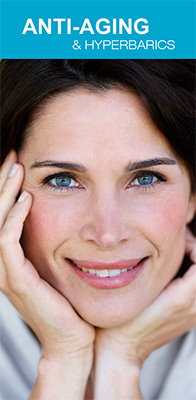Hyperbaric Oxygen Therapy for Treating Age-Related Diseases and Increasing Longevity
Age-related diseases are a growing concern worldwide. Individuals working on life extension are also a growing community.

Hyperbaric oxygen therapy offers support:
- Treating age-related diseases
- Exploring ways to increase longevity
Hyperbaric oxygen therapy (HBOT) has been shown in some studies to help combat degeneration by contributing to the regeneration of tissue and blood vessels.
The therapy stimulates the development of new blood vessels in areas of the body where circulation is compromised and is utilized by some physicians to help treat Coronary Heart Disease, Macular Degeneration, Parkinson’s disease, Alzheimer’s disease, Arthritis and immune-related diseases.
HBOT also helps promote collagen activation to help battle the signs of aging including skin damage and elasticity.
Clinical studies have demonstrated the benefits of HBOT for age-related degenerative conditions by providing cellular aid to all organs in the body to promote health and beauty.
Benefits of Hyperbaric Oxygen Therapy When Treating Age-Related Conditions
Benefits for Circulation and General Blood Flow
- Stimulates angiogenesis (growth of new blood vessels) – essential for healing, growth, development, and maintenance
- Ameliorates atherosclerosis
- Combats and Prevents Circulatory Diseases, Including Coronary Heart Disease (CHD) and Diabetes
How the Heart is Helped with HBOT
- Improves oxygenation to cardiac tissue
- Reduces risk of heart attack
- Improves heart muscle functioning following heart attack
Anti-Aging Support for the Brain with HBOT
- Stimulates neurogenesis
- Promotes neuroplasticity
- Improves memory and reaction time
Supporting the Joints, Soft Tissue and Bones with HBOT
- Ameliorates osteoarthritis and rheumatoid arthritis
- Accelerates healing
- Reduces inflammation and pain
- Improves mobility and stamina
HBOT Benefits for Eyes as We Age
- Helps combat age-related macular degeneration
- Ameliorates diabetic retinopathy
- Reduces central retinal artery occlusion
- Attenuates glaucoma symptoms
Source: International Hyperbarics Association
Information on this website is provided for educational purposes only. It is not intended as a substitute for the diagnosis, treatment, and advice of a qualified licensed professional. This website offers general information and in no way should anyone consider that this website represents the practice of medicine. This website assumes no responsibility for how this information is used. Also note that this website frequently updates its contents, due to a variety of reasons. No statements or implied treatments on this website have been evaluated or approved by the FDA. It is important that you do not reduce, change, or discontinue any medication or treatment without first consulting your doctor. Please consult your doctor before beginning any new program of treatment.
Supporting Research
We’ve selected a few research articles to share with you about hyperbaric oxygen therapy and how it supports age-related conditions and anti-aging strategies.
Have a specific condition you would like more information about? Please contact us!
Study: Effect of hyperbaric oxygen on BDNF-release and neuroprotection
BDNF – Brain-derived neurotrophic factor – is a protein the body releases to stimulate the production of new brain cells. A process is known as neurogenesis. You need this protein to support your learning, memory, higher thinking, and other similar brain functions. Of important interest, the protein is found to be significantly reduced in the brains of people with Alzheimer’s, Parkinson’s, and Huntington’s disease. Researchers are steadily gaining in their understanding of BDNF and how it affects brain plasticity and regeneration. It is already established that hyperbaric oxygen therapy can support brain regenerative effects. A new study, published in 2017, continues to support this concept. Researchers used a lower pressure of 1.5 ATA along with 2.0 ATA, and found that both pressures were able to cause significant increases in BDNF in just 3 to 5 days of consecutive HBOT sessions.
“Both, the genetically modified NIH3T3/BDNF and native NIH3T3 fibroblasts, showed a highly significant increased proliferation after five days of HBOT in comparison to normoxic controls. “
Study: Skin Damage from Ultraviolet Radiation Prevented with HBOT
A study published in 2012 in “Cell Stress and Chaperones, A Comprehensive Journal of Stress Biology and Medicine” focused on the effects of HBOT preconditioning and its protective properties against Ultraviolet-A (UV-A) induced skin damage. Three groups of hairless mice were exposed to UV-A, three days a week for 22 weeks, with two of the groups receiving HBOT pretreatment either two or four times a week. UV-A exposure amplified skin cell death, signifying elevated levels of skin damage. Pretreatment with HBOT substantially reduced UV-A induced cell death. In addition, HBOT pretreatment prevented skin creasing and maintained skin elasticity.
Read the full study: “Hyperbaric oxygen preconditioning protects skin from UV-A damage”.

